EASST2018 on Twitter and in the ‘real world’
Nils Matzner
September 10, 2018 | Report-Backs
Editors Comment: This blogpost came about through an open and critical exchange about ‘who’ and ‘how’ data visualisations are used to summarise conference matters in the making. This blogpost was realized through further exchanges at 4S in Sydney between myself (Amanda Windle) and Nils Matzner, which turned a TwitterTM exchange into a report back on our co-isolated and yet shared experiences of conference participation. It was through transnational social media interactions that we were able to finally meet in person and continue our digital correspondence in this blogpost.
Titled “Making Science, Technology and Society together, the EASST2018 conference was held at the Lancaster University campus. The meeting covered seven streams with 120 panels in total ranging from STS evergreens like socio-technical imaginaries to newer trends such as data infrastructure, predictive policing, smart cities, outer space, climate engineering, or experimental democracy. While any of the activities were summarized, commented, re- or co-produced on TwitterTM, some conference activities were, as might be expected, hidden from the realm of social media.
The 950 participants (569 were active at least once on Twitter) created a friendly and supportive atmosphere. In the plenary “meeting energy”, the deputy mayor and counsellor gave a warm and also bilingual welcoming speech. Counsellor, Claire Cozler was followed by the panelists Andy Stirling, João Camargo, and Gillian Kelly. Kelly, a 74 year-old senior local psychotherapist and recent direct activist (as publicized in the programme), impressed the auditorium with her consequent three-generations-resistance against fracking. While Camargo – an animal scientist and environmental engineer and political activist – gave meta-narratives of energy marketing, Stirling, – a Professor of Science and Technology Policy – wondered why we are still obsessed with nuclear power? The energy system, he concluded, is very much entangled with the state and military. TwitterTM users evaluated this exchange, as well as other plenaries including keynotes by Maria Puig de la Bella Casa and Starhawk, very positively.
With an almost balanced number of tweets and retweets (in total 1300 resp. 1286) the number of tweets perhaps unusually peaked on the third conference day.
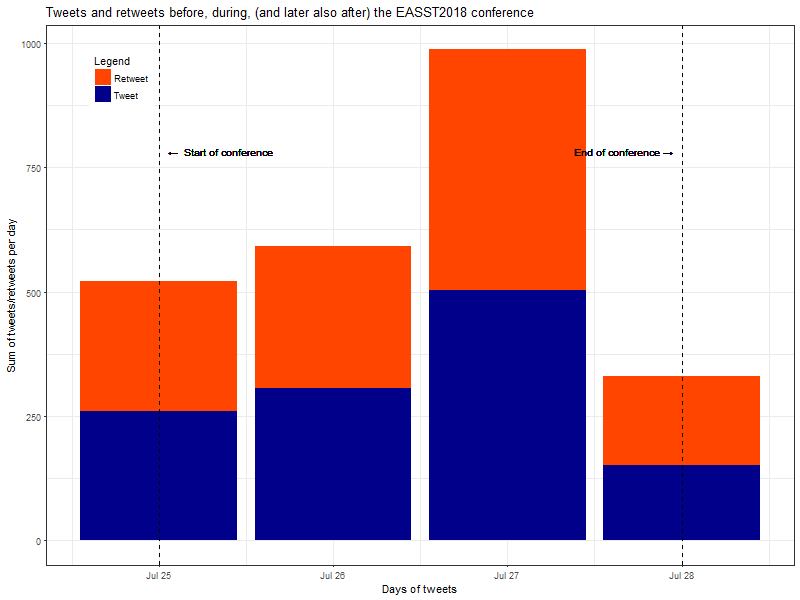
When looking at the replies on the #easst2018-TwitterTM-network, the users created a dense structure with a small number of outliers. This could be seen as a social media representation of the intense discussions in panels and coffee breaks. Unlike some other Twitter discourses (e.g. Procter et al., 2013), the most famous people are not actually the central nodes but that isn’t to say that experienced Professors don’t tweet, both Maria Puig de la Bellacasa and Starhawk tweeted, with the former giving support to panels on soils and compost throughout the conference.
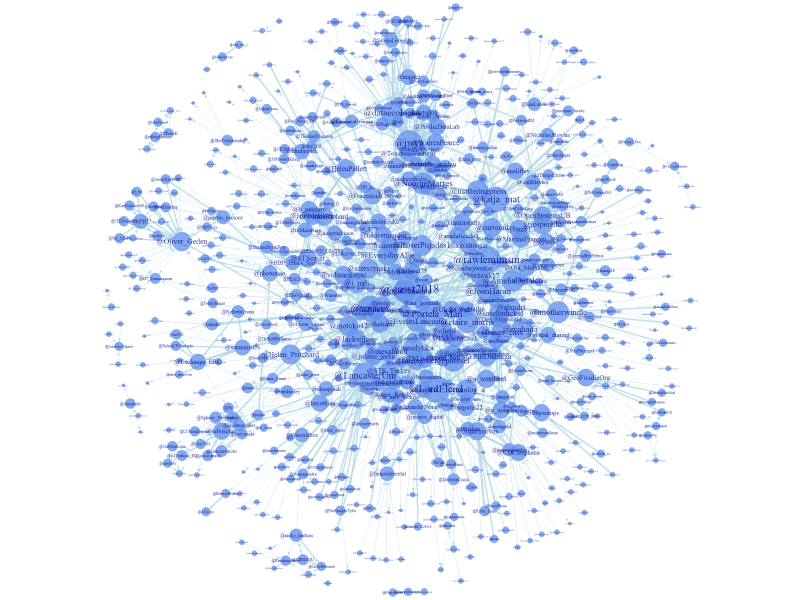
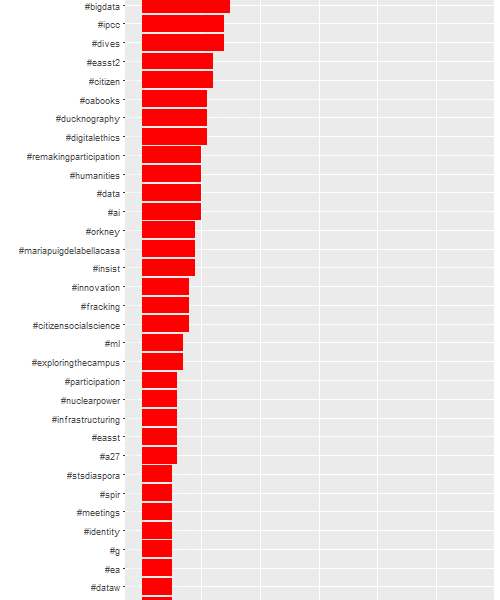
#citizenscience was the trending hashtag after generic terms of the EASST-discourse #easst2018 and #sts. Although only one panel was titled citizen science, the topic was popular in many presentations. The hashtags #mobilites, #feministfigures, and #dataactivism in were trending on ranks 3 to 5. (It is to be noted, that all these trends are absolute counts without using TwitterTM’s recommendation algorithm.) Data infrastructures, algorithms, and ICT were consistently investigated; however, social media itself was a method of the conference, rather than a topic for discussion within the panels.
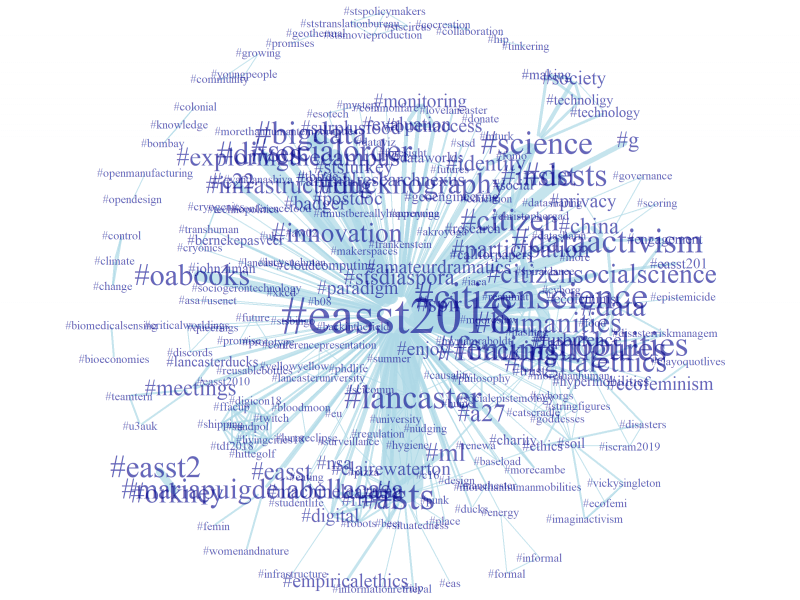
The considerate discussions at the EASST 2018 panels and plenaries perhaps came with the downside of being less critical. Critical remarks were present in panels. However, the mode of social critique was only sporadically used which some discussants criticized. The TwitterTM discussion barely differed in that matter. However, some remarks were tweeted that might not be spoken out loud, such as: “Thanks to the person who came to [a] panel with their child. It's so important to create acceptance for children at conferences and make them more inclusive” (@BornDoro). EASST had several events organised for children (although a crèche was not provided due to insurance and legal issues) throughout the conference for those parenting during the conference including ‘Mad Science Camp’ for children aged five and upwards.
Furthermore, social media-typical jokes related to STS were present as well;
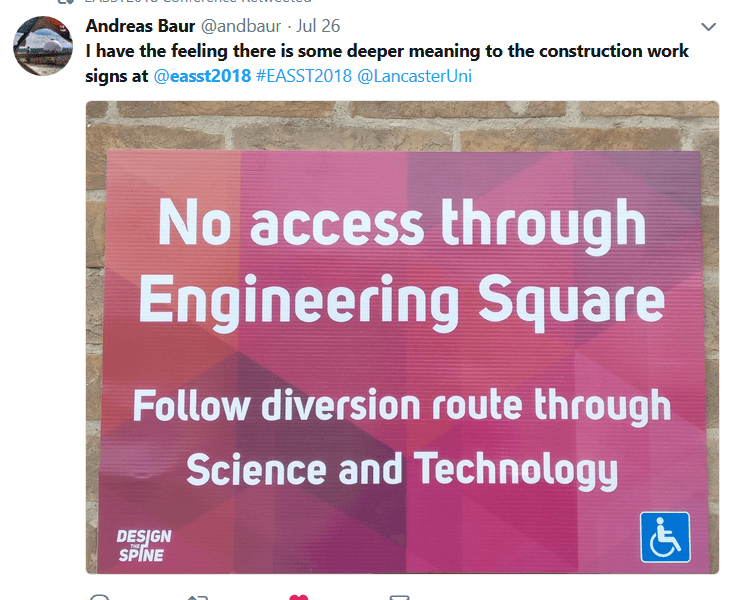
The evening ‘social event’ of the conference offered two bands. The first band captivated the audience with its manual-digital co-creation of yet unheard sounds. This act was a one-man-show of a techno-wizard dressed musician, which made a great impression on many participants. One TwitterTM user dubbed the performance as: “best music concert at conference ever!!!” (@katja_mat). The second act motivated a large crowd of participants to dance, however, was not as much present in the TwitterTM-sphere. On a final playful moment, the freewheeling ducks that had free-range of the entire campus, including some of the lecture rooms, led to many participants’ delight and the trending hashtag #ducknography. With these observations in mind, it helped to have a funny or somehow other original idea to be trending in the #east2018-discourse.
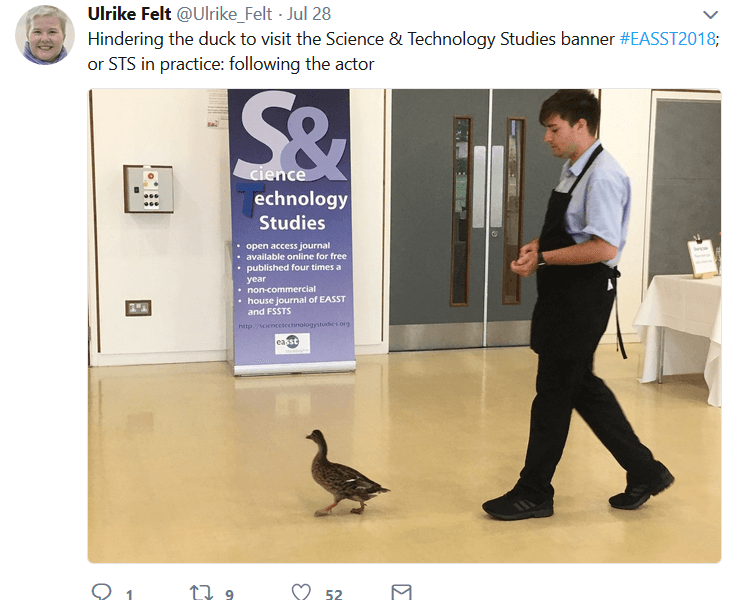
TwitterTM analysis – according to Richard Rogers (2013) – moved from seeing TwitterTM as a what-I-had-for-breakfast-medium to the exploration of an archived data set. Furthermore, Noortje Marres along with Brit Ross Winthereik suggested a need for “situated analytics” in regard to our social data (EASST, 2018). It is worth noting that my own TwitterTM feed does seem to show a situated bias towards Austria-based tweets which might be to do with the location filters on TwitterTM. Raw data was taken for some of the data visualisations above, but how ‘raw’ is that data is a contested issue and an aspect of how data is potentially hidden from certain views (i.e. personal feed versus viewing all or most shared Tweets from the conference hashtag).
Twitter data allows event-following and furthermore opens up a communicative space of its own. Although #ducknography and other tweets that are beyond pure professional discussion catch a lot of attention, Twitter studies have to be “debanalized” (Rogers, ibid.). Following the TwitterTM activities of a conference reveals certain conversation and hides others. The TwitterTM-sphere has its own rules in which not-so-big names might have a say. Critical discussions on TwitterTM – in STS as elsewhere – are possible and one of these discussions led to this article.
Nils Matzner is a research fellow in the Department of Science, Technology and Society Studies at Alpen-Adria-Universität in Klagenfurt Austria.
Published: 09/10/2018
